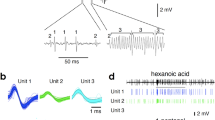Abstract
Solitary fathead minnows (Pimephales promelas) were rendered anosmic and exposed to chemical stimuli from a predatory northern pike (Esox lucius) to determine the role of olfaction in the minnow's ability to recognize predators on the basis of chemical stimuli. Anosmic fish did not respond to the pike stimuli with a typical fright reaction, while control fish, with intact olfactory receptors, did. These results demonstrate that the olfactory system is necessary for the ability of fathead minnows to recognize northern pike as a predator and that the gustatory and single-celled chemosensory systems are not sufficient for this recognition in the absence of olfactory input. Olfactory impairment was behaviorally confirmed by exposing minnows to alarm substance (Schreckstoff).
Similar content being viewed by others
References
Baatrup, E., andDoving, K.B. 1985. Physiological studies on solitary receptors of the oral disc papillae in the adult brook lamprey,Lampetra planeri (Bloch).Chem. Senses 10:559–566.
Frisch, K. Von. 1941. Über einen Schreckstoff der Fischhaut and seine biologische Bedeutung.Z. vergl. Physiol. 29:46–145.
Hara, T.J. 1971. Chemoreception, pp. 79–114,in W.S. Hoar and D.J. Randall (eds.). Fish Physiology, Vol. 5, Sensory Systems and Electric Organs. Academic Press, New York.
Idler, D.R., Fagerlund, U.H., andMayoh, H. 1956. Olfactory perception in migrating salmon. I. L-Serine, a salmon repellent in mammalian skin.J. Gen. Physiol. 39:889–892.
Kasumyan, A.O., andPashchenko, N.I. 1985. Olfactory way of alarm kairomone perception by fishes.Vest. Mosk. Univ. Biol. 40:50–54.
Kats, L.B. 1988. The detection of certain predators via olfaction by small-mouthed salamander larvae (Ambystoma texanum).Behav. Neural Biol. 50:126–131.
Keefe, M. 1992. Chemically mediated avoidance behaviour in wild brook trout: The response to familiar and unfamiliar predaceous fishes and the influences of fish diet.Can. J. Zool. 70:288–292.
Kleerekoper, H. 1969. Olfaction in Fishes. Indiana University Press, Bloomington.
Kotrschal, K. 1991. Solitary chemosensory cells-taste, common chemical sense or what?Rev. Fish Biol. Fish. 1:3–22.
Kotrschal, K., Peters, R., andAtema, J. 1989. A novel chemosensory system in fish: Do rocklings (Ciliata mustela Gadidae) use their solitary chemoreceptor cells as fish detectors?Biol. Bull. Woods Hole, Mass. 177:328.
Kotrschal, K., Brandstatter, R., Gomahr, A., Junger, H., Palzenberger, M., andZaunreiter, M. 1991. Brain and sensory systems,in I.J. Winfield and J.S. Nelson (eds.). Cyprinid Fishes: Systematics, Biology and Exploitation. Chapman and Hall, London.
Lawrence, B.J., andSmith, R.J.F. 1989. Behavioral response of solitary fathead minnows,Pimephales promelas, to alarm substance.J. Chem. Ecol. 15:209–219.
Lemly, A.D., andSmith, R.J.F. 1986. A behavioural assay for assessing effects of pollutants on fish chemoreception.Ecotoxicol. Environ. Safety 11:210–218.
Lemly, A.D., andSmith, R.J.F. 1987. Effects of chronic exposure to acidified water on chemoreception of feeding stimuli in fathead minnows (Pimephales promelas): Mechanisms and ecological implications.Environ. Toxicol. Chem. 6:225–238.
Mathis, A., andSmith, R.J.F. 1993. Fathead minnows (Pimephales promelas) learn to recognize pike (Esox lucius) as predators on the basis of chemical stimuli from minnows in the pike's diet.Anim. Behav. In press.
Mathis, A.,Chivers, D.P., andSmith, R.J.F. 1993. Population differences in responses of fathead minnows (Pimephales promelas) to visual and chemical stimuli from predators.Ethology. In press,
Peters, R.C., Van Steenderen, G.W., andKotrschal, K. 1987. A chemoreceptive function for the anterior dorsal fin in rocklings (Gaidropsarus andCiliata: Teleostei: Gadidae): Electrophysiological evidence.J. Mar Biol. Assoc. U.K. 67:819–823.
Peters, R.C., Kotrschal, K., Drautgartner, W.-D., andAtema, J. 1990. A novel chemosensory system in fish: electrophysiological evidence for mucus detection by solitary chemoreceptor cells in rocklings (Ciliata mustela, Gadidae).Biol. Bull. Woods Hole, Mass. 177:329.
Peters, R.C., Kotrschal, K., andDrautgartner, W.-D. 1991. Solitary chemoreceptor cells ofCiliata mustela (Gadidae, Teleostei) are tuned to mucoid stimuli.Chem. Senses 16:31–42.
Pfeiffer, W., Manglold-Wernado, U. andNeusteuer, P. 1984. Identification of the nerve bundle in the tractus olfactorius of the tench,Tinca tinca L., which conducts the nervous excitation elicited by the alarm substance.Experientia 40:219–220.
Pfeiffer, W., Riegelbauer, G., Meir, G., andScheibler, B. 1985. Effects of hypoxanthine-3-(N)-oxide and hypoxanthine-1-(N)-oxide on central nervous excitation of the black tetraGymnocorymbus ternetzi (Characidae, Ostariophysi, Pisces) indicated by dorsal light response.J. Chem. Ecol. 11:507–524.
Rehnberg, E.G., Jonasson, B., andSchreck, C.B. 1985. Olfactory sensitivity during parr and smolt development stages of coho salmon.Am. Fish. Soc. Trans. 114:732–736.
Savino, J.F., andStein, R.A. 1989. Behaviour of fish predators and their prey: Habitat choice between open water and dense vegetation.Environ. Biol. Fish. 24:287–293.
Siegel, S. 1956. Nonparametric Statistics for the Behavioral Sciences. McGraw-Hill, New York, 312 pp.
Siegel, S., andCastellan, N.J. 1988. Nonparametric Statistics for the Behavioral Sciences. McGraw-Hill, New York, 399 pp.
Silver, W.L., andFinger, T.E. 1984. Electrophysiological examination of a non-olfactory, nongustatory chemosense in the searobin,Prionotus carolinus.J. Comp. Physiol. A 154:167–174.
Smith, R.J.F. 1992. Alarm signals in fishes.Rev. Fish Biol. Fish. 2:33–63.
Webster, D.B. 1973. Audition, vision, and olfaction in kangaroo rat predator avoidance.Am. Zool. 13:1346A.
Weldon, P.J. 1990. Responses of vertebrates to chemicals from predators, pp. 500–521,in D. W. MacDonald, C. Müller-Schwarze, and R.M. Silverstein (eds.). Chemical Signals in Vertebrates V. Plenum Press, New York.
Whitear, M. 1971. Cell specialization and sensory function in fish epidermis.J. Zool. London 163:237–264.
Whitear, M., andLane, E.B. 1983. Oligovillous cells of the epidermis: Sensory elements of lamprey skin.J. Zool. London 199:359–384.
Author information
Authors and Affiliations
Rights and permissions
About this article
Cite this article
Chivers, D.P., Smith, R.J.F. The role of olfaction in chemosensory-based predator recognition in the fathead minnow,Pimephales promelas . J Chem Ecol 19, 623–633 (1993). https://doi.org/10.1007/BF00984997
Received:
Accepted:
Issue Date:
DOI: https://doi.org/10.1007/BF00984997




